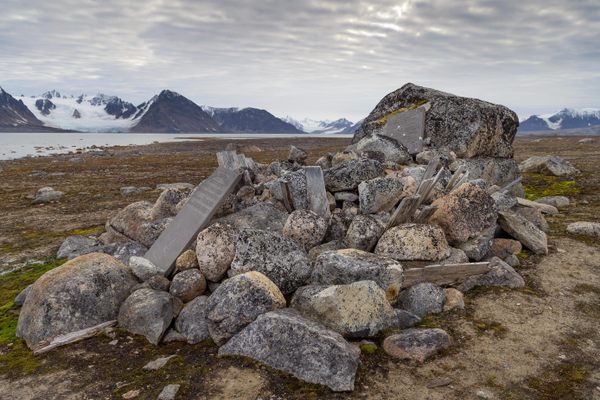Remembering the Coral Route and Its Luxurious Flying Boats
For a brief period of time, the rich and famous used seaplanes to island hop across the Pacific.

At their lowest, the Solent flying boats dipped so close to the waters of the Pacific Ocean that passengers could pick out brilliant coral formations, whales, and even the occasional shark from their windows. Starting in 1951, Tasman Empire Airways Limited (TEAL) operated the Coral Route, a monthly island-hopping extravaganza for some of the world’s glitziest people. Within six months, demand was so great that the airline doubled its services. But by the end of 1960, it was all over and the islands, touched for a brief period by seaplane magic, were brought abruptly back to normal.
It started with a mail service. In the wake of the Second World War, New Zealand found itself with an impressive fleet of pilots, who had learned to wrangle tide charts and coral reefs alike as they came in to land in the lagoons of the South Pacific. And so, in the final days of the British Empire, the Royal New Zealand Air Force ferried mail from one island outpost to the next, everywhere from Tahiti to Fiji.

But, as enthusiast Stewart Haynes writes, “a scheduled air service, flying boats linking islands scattered over thousands of miles on the South Seas; silver craft putting down oh-so-softly in tropical lagoons … was just too appealing.” The seaplanes continued to take mail, but began bringing passengers with them, on a romantic tourist package that left Auckland for the first time in late December 1951. The name “Coral Route” came from a TEAL staff competition: the head steward, Eric Mullane, was inspired by both the beauty of the coral islands and the “choral” musical welcome that guests received on their arrival in each spot.
For two and a half days, Coral Route passengers would hop from flying boat to island, and from island to flying boat, on a journey nearly 5,000 miles long. The trip began in Auckland, New Zealand, traveling through to Suva in Fiji, the Cook Islands, and Tahiti. Stops to Samoa and then Tonga were introduced in 1952.

Passengers sat in luxury in TEAL’s Solent flying boats, which were hulled like a boat, but with wings like a plane, allowing them to take off and land on water. First developed in the late 1940s as part of the war effort, the seaplanes seated up to 45 passengers over two decks, and included a five-strong crew, including a chef. Like the zeppelins of just a few decades earlier, passengers enjoyed a full silver service on board, with fresh linen tablecloths and meals cooked to order. The airline’s two Solent boats—named Aparima, after a Tahitian dance, and Aranui, a Māori word meaning “the great path”—cruised at speeds of around 170 miles per hour, in decadent sky-high surroundings. Each guest had paid £30 for their transit, about a third of the annual U.K. salary in the year the service began.
For many passengers, the crowning jewel of the route was the island of Akaiami, an uninhabited islet in the Cook Islands. New Zealand Geographic describes an islet almost parodic in its deserted perfection: shallow, turquoise waters beset with garlands of tropical fish; coconut palms; glittering silver sands. The flying boats landed at dawn, before the sun could climb too high in the sky, and drag the thermostat up with it. TEAL staff on the ground had, the night before, marked out a water landing area with inflatable buoys; the flying boats were then anchored in Akaiami Bay, while crew scrambled to fill the plane with fuel using a refueling barge.
This hectic behind-the-scenes activity was usually kept out of sight of the passengers. Though exhausted—they had taken off from Apia, the capital of Samoa, at 1 a.m.—for a few, brief hours, they enjoyed moments of absolute serenity, hundreds of miles from civilization. After being ferried off the flying boat, guests were welcomed onto the passenger wharf, and decorated with sweet-smelling flower leis by people from nearby Aitutaki, one of the Cook Islands.
For the roughly 2,000 locals of Aitutaki, the arrival of the seaplane to Akaiami was a high point in the week. Aitutaki villagers lived an easy existence in huts with wooden walls and roofs thatched with coconut palms. When the flying boat arrived, children stood agape on the beach, trying to spot someone they might have heard of—although Aitutaki was at that time so isolated from the rest of the world that even the most renowned personality would be likely unrecognizable.

This uninhabited island paradise was, for a few years, witness to some of the world’s most glamorous people, including Marlon Brando, who liked Akaiami so much he returned a second time while filming Mutiny on the Bounty, and the Crown Prince of Tonga, who reportedly needed a custom-made seat to accommodate his bulk. Passengers recuperated in the thatched TEAL guest house, splashed in the shallow waters, or simply wandered the two miles along the island’s coast.
As a little girl, Queen Manarangi Tutai, now one of Aitutaki’s three high chiefs, remembered often taking a large canoe to Akaiami in the early 1950s with her family, on the night before the plane’s arrival. This was an easy journey of five miles on her father’s sailing canoe, with its mighty cotton sail. When they made it to the islet, they would stay in a local hut, sitting beneath the stars on a coconut log by a hissing billy cooking pot. “We seemed so isolated, so remote, and yet, for a brief instance the next day, Akaiami would be the only place in the whole Cook Islands where we would be so very close to the outside world,” she wrote, on her personal website. “We were, for a very short time, an international airport.”

At 9 a.m., Tutai recalled, the plane would make radio contact with TEAL staff on the ground. “A shout would go up, and everyone would man their stations,” she wrote. “We all would strain our eyes to see her, vying to be the first. Then, there she was, a speck, gradually becoming larger and larger—then a huge seaplane lining up with the water landing area in the lagoon.” The plane flew lower and lower, until it was just skimming the surf, before settling on the water and taxiing over the buoy. “In the peace of Akaiami, I can still remember the deafening roar of those big engines, and the silence that followed when they were stopped. It just seemed to make the stillness much greater somehow.”
The travelers were an exciting addition to island life, providing a brief glimpse at the outside world, far from the South Pacific, and welcomed accordingly with celebration and singing. In Papeete, in Tahiti, every boatload of disembarking guests was greeted with a dance called “Soirée de TEAL.” The night before, the village’s restaurants and bars displayed blackboards outside, which proclaimed: “L’avion TEAL arrivera demain”—“The TEAL plane is coming tomorrow.” Bars put on special parties to welcome them, and Solent crew and passengers alike treated like stars. Often, they were.
Despite its popularity with both passengers and Pacific Islanders, in September 1960, the service ceased. TEAL had inherited landplanes from a British airline, and the Solents were slowly phased out. First, they vanished from TEAL’s Tasman Strait crossings between New Zealand and Australia. Then, after a new international airport was built at Papeete, landplanes took over the journeys between the Pacific Islands, bringing the Coral Route to an end. By 1965, TEAL was rechristened Air New Zealand, and the service all but forgotten. A glorious chapter in aviation history had come to a close. After a decade of welcoming strangers from far away to their sandy homelands, the islanders, and their islands, went back to the way things had been before.



















Follow us on Twitter to get the latest on the world's hidden wonders.
Like us on Facebook to get the latest on the world's hidden wonders.
Follow us on Twitter Like us on Facebook